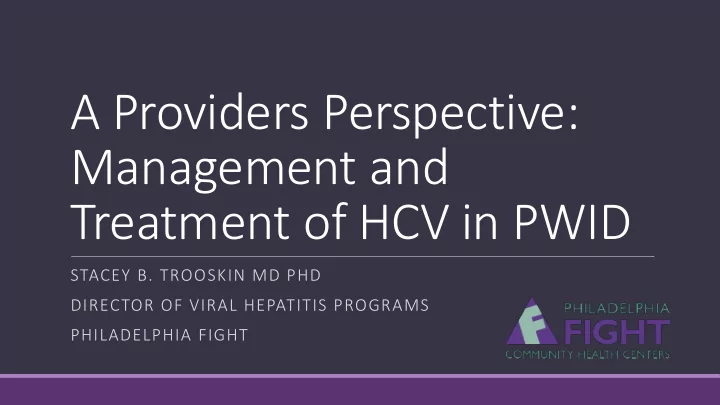

A Providers Perspective: Management and Treatment of HCV in PWID STACEY B. TROOSKIN MD PHD DIRECTOR OF VIRAL HEPATITIS PROGRAMS PHILADELPHIA FIGHT
Treating PWID as a priority Everyone deserves a cure ◦ Decreased morbidity ◦ Decreased mortality Added public health benefit ◦ Treatment is prevention
Challenges Patient based barriers ◦ Trust of the medical establishment ◦ Shame ◦ Misinformation Provider based barriers ◦ Stigma ◦ Discomfort with harm reduction counseling ◦ Lack of experience System based barriers ◦ Restrictions/ treatment criteria ◦ Concern for reinfection Barua S et al., Ann Intern Med. 2015;163(3):215-223 Canary LA et al., Ann Intern Med. 2015;163(3):226-228
Reinfection Reported rates of reinfection following successful HCV treatment among PWID vary ◦ 1-5% risk / year (interferon era) ◦ 2.4 or 3.4-10.5 reinfections per 100 person years ◦ 25% over 3 years among HIV + MSM PWID should not be excluded form HCV treatment on the basis of perceived risk of reinfection Harm reduction education and counseling should be Post treatment (SVR), monitoring for reinfection should occur using PCR testing Cunningham, EB et al. Nat Rev Gastro and Hep. 2015. 12(4), 218-230. Grady B et al. CID . 2013, 5(S2) S105-S110. Martin, T. EASL 2016. Abstract # Dore, GJ. EASL 2016 Abstract # sat-163.
HCV Treatment in PWID works In studies of IFN-containing treatments in persons who inject drugs, adherence and efficacy rates are comparable to those of patients who do not use injection drugs. C- Edge costar demonstrated high levels of adherence (96-100%) to Grazoprevir/ elbasvir among patients with high rates of drug use Aspinall, E. 2103, CID. 57(Suppl 2):S80-S89 Dore GJ, 2016, EASL abstract #sat-163
AASLD/IDSA: Who should be treated? Treatment is recommended for all patients with chronic HCV infection, except those with short life expectancies that cannot be remediated by treating HCV, by transplantation, or by other directed therapy. Patients with short life expectancies owing to liver disease should be managed in consultation with an expert. www.hcvguidelines.org
Treatment Consider treatment on individualized basis ◦ Assessment of ability to adhere to and complete prescribed regimen ◦ Education ◦ Cultural issues ◦ Social support ◦ Nutrition/ food security ◦ Assessment of ability to attend follow up appointments ◦ Housing ◦ Employment ◦ Phone access ◦ Legal issues (warrants, upcoming court dates) ◦ Assessment of dual diagnoses/ other psychiatric co-morbid conditions
Treatment Create an Individualized treatment plan ◦ Multidisciplinary care ◦ Pharmacist ◦ Social worker ◦ Navigator ◦ Mental Health services ◦ DOT vs weekly vs monthly refills ◦ Assistance with transportation needs ◦ Coordinate care with community based social services
Obtaining DAA approval Can be challenging ◦ Sobriety Requirement ◦ Disease Severity Requirement Clear, honest documentation in progress notes Clear, honest conversation with patients Depending on the payer: ◦ Clean urine drug screen ◦ Clean blood alcohol level
V. LoRe. AASLD 2015, LB-5.
Current Challenges in HCV Care Peer to Submit Prior Denial Denial Denial Appeal Appeal Peer Authorization Grievance Approximately 8 hrs of staff time per patient 1 to 4 months to go through the process
When insurance will not cover drugs what are the options? Wait for new drugs to be approved ◦ No guarantee that those will be covered/ patient will qualify Wait until patient qualifies ◦ Sobriety ◦ Worsening fibrosis Take legal action Apply to patient assistance programs to obtain free drug ◦ There is only one company that does this currently ◦ Financial information to qualify ◦ Proof that patient does not qualify for insurance ◦ Challenging to navigate
Harm Reduction ◦ Linkage to Opioid Substitution Treatment (OST) ◦ Resources for sterile drug injecting equipment ◦ Education regarding safe injection practices and reinfection ◦ Counseling regarding reduction/ cessation of alcohol use ◦ Safer sex ◦ Weight management
Secondary Prevention for patients with cirrhosis ◦ Counseling ◦ Limit Tylenol use ◦ Avoid raw seafood ◦ Additional Screening ◦ Hepatocellular Carcinoma (HCC) ◦ Ultrasounds every 6 months (vs CT or MRI) ◦ Esophageal Varices ◦ Upper endoscopy
Progress in PA May 2015 ◦ Removal of sobriety requirement ◦ Increased access for metavir score of F2 or higher ◦ All patient with HIV or HBV coinfection, extrahepatic manifestations were given access irrespective of disease stage May 2016 ◦ P and T committee for PA State Medicaid program voted to open access to F0 for all patients ◦ Waiting on Secretary Ted Dallas to approve or deny
Advocacy in Philadelphia ◦ Philadelphia-area collective dedicated to improving the continuum of hepatitis C prevention, care, and support services in Philadelphia A program of www.hepcap.org
Recommend
More recommend